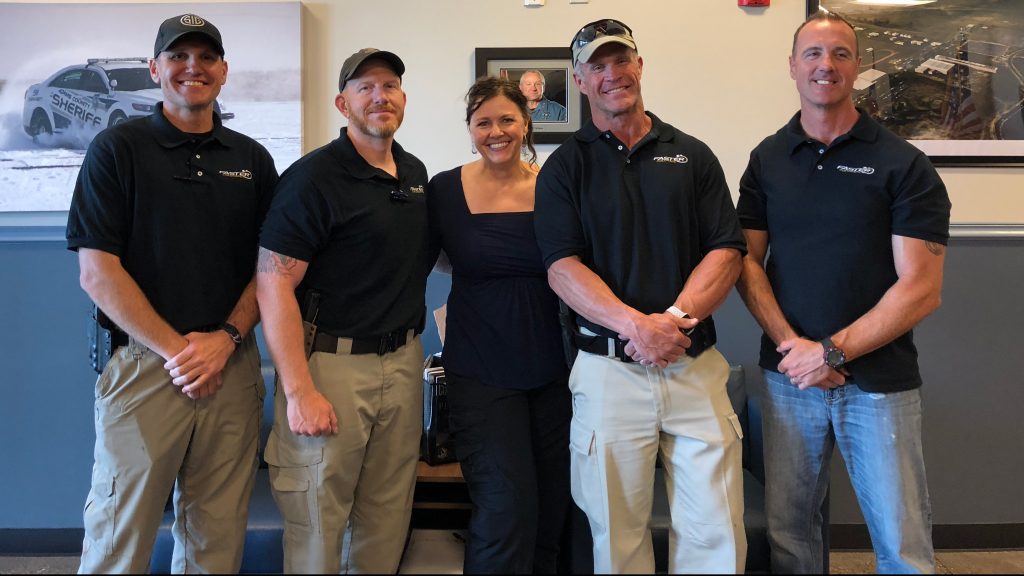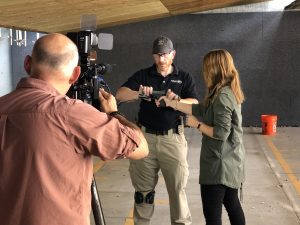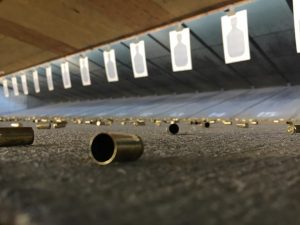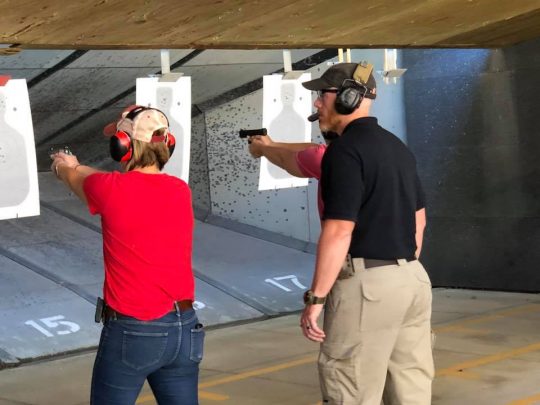Quinn Cunningham has 23 years of law enforcement experience including 17 years with a Colorado SWAT team, in which he is currently a team leader. He was one of the first responders to a deadly 2013 shooting at a high school near Denver. Since 2015, he has been actively training teachers to carry inside their schools.
During a recent three-day FASTER Colorado training course for teachers, where Cunningham was one of four active-duty law enforcement officer instructors, he shared his experience and worldview with the Washington Free Beacon. Although Cunningham is prohibited from disclosing the identity of the school or students involved in the attack by his agency's policy, the timing and details point to the events at a high school in suburban Denver.
The story began just before 12:33 p.m. on Dec. 13, 2013, when an 18-year-old student entered Arapahoe High School with a pump-action shotgun and a bag full of Molotov cocktails. As he opened fire, the call for help went out to local law enforcement. Cunningham was among the massive number of police who responded to the attack.
"When something like that happens, pretty much the whole city comes," Cunningham told the Free Beacon. "The whole metro area came. I was about twelfth into the school from what I understand. We went into the school, and we’re moving through the hallways. It was me and two other cops who I had never seen before. I don’t remember what agency they’re with and I haven’t seen them since. And we’re moving through the school, and normally when we do scenario-based training for an active killer, there's a lot of distractions and a lot of fire alarms and role players and all this stuff, screaming going on. And it was dead silence, like deafening, distracting silence. To the point where it was, 'What’s going on? Where are the kids at?' And I’m looking at my watch like, 'What day is it?'"
"They were so good with their lockdown procedures and their active killer procedures that all the kids were barricaded in their classrooms, the doors were locked and they were armed with chairs, fire extinguishers," Cunningham said. "If anyone came to that door, they were going to fight."
After entering the school, the attacker came upon 17-year-old Claire Esther Davis. He shot her in the head before chasing a teacher to the school library where he set off the Molotov cocktails and eventually shot himself. The attack was over in less than 2 minutes. It was only 46 seconds between the time when the school resource officer called for help and when the shooter took his own life.
Witnessing the scene of Davis's murder had a profound impact on Cunningham.
"So, we're moving through the school, and I came around the corner and there's the crime scene," Cunningham said. "Forty-six seconds, we lost one student. The reason I'm doing this is because of that crime scene."
He said he'll never forget what he saw that day.
"And it's still to this day kind of hard to talk about it," he said while choking back tears, "because it's just seared in my skull."
"What had happened is when he took off towards the library, one of the unarmed security guards picked her up and tried to take her to help," Cunningham began to explain. "So, he went one end of the school, which was towards the library, and there were shots fired, the guy threw some bombs and so he turned around and went back out. There's about a 50-yard blood trail that went down, and about a 50-yard blood trail that went back. And she was sitting on this bench. And one of the shots he missed, and you could tell the impact on the wall, and you could tell the impact on the wall where she was hit, and there was debris, blood, footprints in the blood, and pieces of the brick all over the ground. And the thing that sticks with me forever is I looked down in the middle of this blood and right there was this lock of hair. Long, very beautiful lock of hair. And I didn’t freeze, but time ceased to exist. It just wasn't a factor anymore. I was looking at that hair and it was beautiful in the middle of all this chaos. And her beauty transcended that evil."
He said he made a lifelong commitment that day.
"I made a promise to her," Cunningham said. "I made a promise to her that I couldn't give my life for her that day, but I’ll give every day of my fucking life for her. For the rest of my days. And that's why I do it. That's why I want this so bad. I want this program so bad because no one deserves to die in their school. No one should go to school worried about getting shot."
In the aftermath of the shooting, Cunningham started his own training program and eventually became involved with FASTER Colorado.

Laura Carno, executive director of FASTER Colorado, said she shares Cunningham's vision for helping teachers protect their students. She pointed to the efforts of teachers to protect their students during recent school shootings despite being unarmed. Her hope is teachers and staff will have the option to train to confront any future attackers with their own firearms.
"If [Marjory Stoneman Douglas High School] Coach Aaron Feis had been armed, he would have been able to protect those kids with something other than his body, he could’ve saved them," she told the Free Beacon. "He could've saved whoever was killed after that, and he would’ve gone home to his family. What about the teachers' right of self-defense or the coach's right of self-defense? Just because they choose that very noble profession they lose their right to self-defense. That's not okay."
Carno also pointed to the shooting at Santa Fe High School as an example of the limitations of armed school resource officers. Unlike Parkland's armed school resource officer, Santa Fe's armed school resource officer intervened in the shooting, but it wasn't enough to save the 10 victims who were murdered by the attacker.
"And then Santa Fe, there was a school resource officer and they also had active shooter training," Carno said. "They were discussing arming staff, they just weren't there yet."

Cunningham said his personal experience reinforced that point. Police—even those stationed in or nearby a school—are unlikely to be the first ones able to respond to an attack, and the longer that response is delayed, the more kids may die.
"With an SRO in the school, 46 seconds we lost a student. Forty-six seconds," he said. "We are not the first responders. You could be in the parking lot, call has to go to dispatch, dispatch has to arrow to you, you have to go. And there’s lag time there, there’s some dwell time there before we can respond. The statistics I’ve heard is every 17 seconds someone is killed in an active shooter situation. Seventeen seconds. If I’m sitting in the parking lot for three minutes before I make entry, do the math. That's too many lives.
"Cops are not the first responders," said Cunningham. "It is the people there, the civilians. Whether it's an active shooter or something happens at Walmart at three o’clock in the morning. You are the first responder, you have the right to protect your life, and cops are the second responders, fire rescue third. When I show up with my SWAT guys in our green pajamas, that’s an hour, hour and a half for us to get all our stuff, all our people and go. That's way too long and that’s what happened at Columbine. Columbine, everybody set up, waited for SWAT while killing was happening."
The two acknowledged there are many concerns that people have about arming teachers in schools. They agreed that not every teacher wants to or even should be allowed to carry a firearm on their school campus.
"I don't think everybody should be armed because not everybody can do it," Cunningham said. "It needs to be a volunteer program, and I think there should be some background checks. There should be some psychological testing and other things to make sure they’re the right people for the job."

Carno said the teachers who are authorized to carry in Colorado schools are thoroughly screened by their local school districts, which ultimately decides if anyone is allowed to carry a firearm and, if so, who exactly the authorized personnel will be, what they will carry, and what kind of training they will be required to obtain.
"When they pick individuals, they don’t say, 'free for all, everybody gets to carry!' It's this person, this person, this person," she said. "Some people say, 'well it shouldn't be Mrs. So-and-So because she once threw a stapler at a kid.' They would know that in a school, and they wouldn’t authorize her even if she raised her hand. There are those safety regulations there and if someone in the school noticed something bad, they can take away that authorization in a minute. That's up to them."
And, no, no teachers are ever forced to carry if they don’t want to.
"It’s one of the biggest myths," Carno said. "We don't force teachers to carry a concealed firearm any more than we would force every American to carry a concealed firearm because there's a law allowing it, it's completely absurd. And they keep bringing it up."
Carno acknowledged that while school shootings are rare and have actually become less frequent in recent decades, she believes common concerns about teachers carrying guns, like accidental shootings or guns being stolen from teachers in school are even rarer.
"So, there are a lot of what-ifs," she said. "What if a kid gets a gun, what if someone is irresponsible with their firearm? There are a lot of what-ifs that are mitigated by the training. Even if we don't see the what-ifs, there's just no stories out there. If this was going to be a big problem, we’d be seeing it."

Still, Carno said FASTER Colorado does train the teachers who go through its course to learn about how to counter potential pitfalls of carrying in school like negligent discharges and weapon retention. "We teach around that," she said.
Ultimately, both said the program, which relies on donations from supporters, is necessary because an armed attacker unleashed inside a school of unarmed children and teachers is too horrific to not try every possible deterrent.
"There's no worse scenario than an armed, deranged man executing child after child after child with nobody to stop him," Carno said. "There is no worse scenario. So, if you talk about accidents, friendly fire, any of these things are even more rare than school shootings. Nothing is worse than somebody just getting to have his way with little children and kill them with nobody to stop him. Anything is better than that."
"I think our kids are our most precious natural resource. Our kids are the furtherance of this great country, our cultures, our customs," Cunningham said. "They are our legacy and they need to be protected more than airports, more than banks. Because they are our most precious commodity."
The greatest hope for gun-training proponents like Cunningham and Carno is that if potential attackers begin to view schools as hardened targets with armed resistance where they might get shot before ever being able to harm somebody else, school shootings may become even more rare or stop altogether.
"When our kids stop being targets because these bad guys know they can't kill kids anymore because they will be met with armed resistance, that will change our culture," Carno said.
UPDATE 10:26 A.M., Monday 23 July: This post has been updated to clarify how the Free Beacon identified the school shooting.
